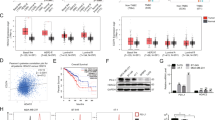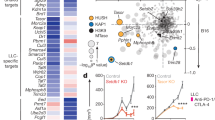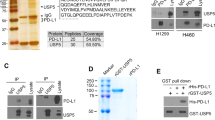Abstract
The expression of the NKG2D ligands on cancer cells leads to their recognition and elimination by host immune responses mediated by natural killer and T cells. UL16-binding proteins (ULBPs) are NKG2D ligands, which are scarcely expressed in epithelial tumours, favouring their evasion from the immune system. Herein, we investigated the epigenetic mechanisms underlying the repression of ULBPs in epithelial cancer cells. We show that ULBP1–3 expression is increased in tumour cells after exposure to the inhibitor of histone deacetylases (HDACs) trichostatin A (TSA), which enhances the natural killer cell-mediated cytotoxicity of HeLa cells. Our experiments showed that the transcription factor Sp3 is crucial in the activation of the ULBP1 promoter by TSA. Furthermore, by small interfering RNA-mediated knockdown and overexpression of HDAC1–3, we showed that HDAC3 is a repressor of ULBPs expression in epithelial cancer cells. Remarkably, TSA treatment caused the complete release of HDAC3 from the ULBP1–3 promoters. HDAC3 is recruited to the ULBP1 promoter through its interaction with Sp3 and TSA treatment interfered with this association. Together, we describe a new mechanism by which cancer cells may evade the immune response through the epigenetic modulation of the ULBPs expression and provide a model in which HDAC inhibitors may favour the elimination of transformed cells by increasing the immunogenicity of epithelial tumours.
This is a preview of subscription content, access via your institution
Access options
Subscribe to this journal
Receive 50 print issues and online access
$259.00 per year
only $5.18 per issue
Buy this article
- Purchase on Springer Link
- Instant access to full article PDF
Prices may be subject to local taxes which are calculated during checkout










Similar content being viewed by others
References
Ammanamanchi S, Freeman JW, Brattain MG . (2003). Acetylated sp3 is a transcriptional activator. J Biol Chem 278: 35775–35780.
Andresen L, Jensen H, Pedersen MT, Hansen KA, Skov S . (2007). Molecular regulation of MHC class I chain-related protein A expression after HDAC-inhibitor treatment of Jurkat T cells. J Immunol 179: 8235–8242.
Andrews NC, Faller DV . (1991). A rapid micropreparation technique for extraction of DNA-binding proteins from limiting numbers of mammalian cells. Nucleic Acids Res 19: 2499.
Armeanu S, Bitzer M, Lauer UM, Venturelli S, Pathil A, Krusch M et al. (2005). Natural killer cell-mediated lysis of hepatoma cells via specific induction of NKG2D ligands by the histone deacetylase inhibitor sodium valproate. Cancer Res 65: 6321–6329.
Bauer S, Groh V, Wu J, Steinle A, Phillips JH, Lanier LL et al. (1999). Activation of NK cells and T cells by NKG2D, a receptor for stress-inducible MICA. Science 285: 727–729.
Bolden JE, Peart MJ, Johnstone RW . (2006). Anticancer activities of histone deacetylase inhibitors. Nat Rev Drug Discov 5: 769–784.
Braun H, Koop R, Ertmer A, Nacht S, Suske G . (2001). Transcription factor Sp3 is regulated by acetylation. Nucleic Acids Res 29: 4994–5000.
Cosman D, Mullberg J, Sutherland CL, Chin W, Armitage R, Fanslow W et al. (2001). ULBPs, novel MHC class I-related molecules, bind to CMV glycoprotein UL16 and stimulate NK cytotoxicity through the NKG2D receptor. Immunity 14: 123–133.
Chen L, Fischle W, Verdin E, Greene WC . (2001). Duration of nuclear NF-kappaB action regulated by reversible acetylation. Science 293: 1653–1657.
Diermayr S, Himmelreich H, Durovic B, Mathys-Schneeberger A, Siegler U, Langenkamp U et al. (2008). NKG2D ligand expression in AML increases in response to HDAC inhibitor valproic acid and contributes to allorecognition by NK-cell lines with single KIR-HLA class I specificities. Blood 111: 1428–1436.
Doetzlhofer A, Rotheneder H, Lagger G, Koranda M, Kurtev V, Brosch G et al. (1999). Histone deacetylase 1 can repress transcription by binding to Sp1. Mol Cell Biol 19: 5504–5511.
Dunn GP, Old LJ, Schreiber RD . (2004a). The immunobiology of cancer immunosurveillance and immunoediting. Immunity 21: 137–148.
Dunn GP, Old LJ, Schreiber RD . (2004b). The three Es of cancer immunoediting. Annu Rev Immunol 22: 329–360.
Fischle W, Dequiedt F, Fillion M, Hendzel MJ, Voelter W, Verdin E . (2001). Human HDAC7 histone deacetylase activity is associated with HDAC3 in vivo. J Biol Chem 276: 35826–35835.
Glozak MA, Seto E . (2007). Histone deacetylases and cancer. Oncogene 26: 5420–5432.
González S, López-Soto A, Suárez-Álvarez B, López-Vázquez A, López-Larrea C . (2008). NKG2D ligands: key targets of the immune response. Trends Immunol 29: 397–403.
Groh V, Wu J, Yee C, Spies T . (2002). Tumour-derived soluble MIC ligands impair expression of NKG2D and T-cell activation. Nature 419: 734–738.
Kaiser BK, Yim D, Chow IT, González S, Dai Z, Mann HH et al. (2007). Disulphide-isomerase-enabled shedding of tumour-associated NKG2D ligands. Nature 447: 482–486.
Karagianni P, Wong J . (2007). HDAC3: taking the SMRT-N-CoRrect road to repression. Oncogene 26: 5439–5449.
Kato N, Tanaka J, Sugita J, Toubai T, Miura Y, Ibata M et al. (2007). Regulation of the expression of MHC class I-related chain A, B (MICA, MICB) via chromatin remodeling and its impact on the susceptibility of leukemic cells to the cytotoxicity of NKG2D-expressing cells. Leukemia 21: 2103–2108.
Knutson SK, Chyla BJ, Amann JM, Bhaskara S, Huppert SS, Hiebert SW . (2008). Liver-specific deletion of histone deacetylase 3 disrupts metabolic transcriptional networks. EMBO J 27: 1017–1028.
Kottilil S, Shin K, Jackson JO, Reitano KN, O'Shea MA, Yang J et al. (2006). Innate immune dysfunction in HIV infection: effect of HIV envelope-NK cell interactions. J Immunol 176: 1107–1114.
Kouzarides T . (2007). Chromatin modifications and their function. Cell 128: 693–705.
Lopez-Larrea C, Suarez-Alvarez B, Lopez-Soto A, Lopez-Vazquez A, Gonzalez S . (2008). The NKG2D receptor: sensing stressed cells. Trends Mol Med 14: 179–189.
López-Soto A, Quiñones-Lombrana A, López-Arbesú R, López-Larrea C, González S . (2006). Transcriptional regulation of ULBP1, a human ligand of the NKG2D receptor. J Biol Chem 281: 30419–30430.
Luo J, Su F, Chen D, Shiloh A, Gu W . (2000). Deacetylation of p53 modulates its effect on cell growth and apoptosis. Nature 408: 377–381.
Maio M, Coral S, Fratta E, Altomonte M, Sigalotti L . (2003). Epigenetic targets for immune intervention in human malignancies. Oncogene 22: 6484–6488.
Minucci S, Pelicci PG . (2006). Histone deacetylase inhibitors and the promise of epigenetic (and more) treatments for cancer. Nat Rev Cancer 6: 38–51.
Nausch N, Cerwenka A . (2008). NKG2D ligands in tumor immunity. Oncogene 27: 5944–5958.
Pende D, Rivera P, Marcenaro S, Chang CC, Biassoni R, Conte R et al. (2002). Major histocompatibility complex class I-related chain A and UL16-binding protein expression on tumor cell lines of different histotypes: analysis of tumor susceptibility to NKG2D-dependent natural killer cell cytotoxicity. Cancer Res 62: 6178–6186.
Ropero S, Ballestar E, Alaminos M, Arango D, Schwartz Jr S, Esteller M . (2008). Transforming pathways unleashed by a HDAC2 mutation in human cancer. Oncogene 27: 4008–4012.
Salih HR, Antropius H, Gieseke F, Lutz SZ, Kanz L, Rammensee HG et al. (2003). Functional expression and release of ligands for the activating immunoreceptor NKG2D in leukemia. Blood 102: 1389–1396.
Saunders LR, Verdin E . (2007). Sirtuins: critical regulators at the crossroads between cancer and aging. Oncogene 26: 5489–5504.
Skov S, Pedersen MT, Andresen L, Straten PT, Woetmann A, Odum N . (2005). Cancer cells become susceptible to natural killer cell killing after exposure to histone deacetylase inhibitors due to glycogen synthase kinase-3-dependent expression of MHC class I-related chain A and B. Cancer Res 65: 11136–11145.
Smyth MJ, Swann J, Cretney E, Zerafa N, Yokoyama WM, Hayakawa Y . (2005). NKG2D function protects the host from tumor initiation. J Exp Med 202: 583–588.
Sowa Y, Orita T, Minamikawa-Hiranabe S, Mizuno T, Nomura H, Sakai T . (1999). Sp3, but not Sp1, mediates the transcriptional activation of the p21/WAF1/Cip1 gene promoter by histone deacetylase inhibitor. Cancer Res 59: 4266–4270.
Sun JM, Chen HY, Moniwa M, Litchfield DW, Seto E, Davie JR . (2002). The transcriptional repressor Sp3 is associated with CK2-phosphorylated histone deacetylase 2. J Biol Chem 277: 35783–35786.
Sutherland CL, Rabinovich B, Chalupny NJ, Brawand P, Miller R, Cosman D . (2006). ULBPs, human ligands of the NKG2D receptor, stimulate tumor immunity with enhancement by IL-15. Blood 108: 1313–1319.
Verdin E, Dequiedt F, Kasler HG . (2003). Class II histone deacetylases: versatile regulators. Trends Genet 19: 286–293.
Waldhauer I, Steinle A . (2008). NK cells and cancer immunosurveillance. Oncogene 27: 5932–5943.
Wilson AJ, Byun DS, Popova N, Murray LB, L'Italien K, Sowa Y et al. (2006). Histone deacetylase 3 (HDAC3) and other class I HDACs regulate colon cell maturation and p21 expression and are deregulated in human colon cancer. J Biol Chem 281: 13548–13558.
Wooten-Blanks LG, Song P, Senkal CE, Ogretmen B . (2007). Mechanisms of ceramide-mediated repression of the human telomerase reverse transcriptase promoter via deacetylation of Sp3 by histone deacetylase 1. FASEB J 21: 3386–3397.
Xu WS, Parmigiani RB, Marks PA . (2007). Histone deacetylase inhibitors: molecular mechanisms of action. Oncogene 26: 5541–5552.
Yang WM, Tsai SC, Wen YD, Fejer G, Seto E . (2002). Functional domains of histone deacetylase-3. J Biol Chem 277: 9447–9454.
Yokota T, Matsuzaki Y, Miyazawa K, Zindy F, Roussel MF, Sakai T . (2004). Histone deacetylase inhibitors activate INK4d gene through Sp1 site in its promoter. Oncogene 23: 5340–5349.
Acknowledgements
We thank Dr Spies and Amgen for kindly providing ULBP antibodies, Dr García de Herreros for providing HT-29 M6 cells, Banco de Tumores del Hospital Universitario Central de Asturias for providing human tumour samples, Dr G Gill for providing the pBS/U6-Scrambled plasmid, Dr A Astudillo for histopathological evaluation, Dr C López-Otín for helpful comments and A Vallina and MS Pitiot for technical assistance. This work was supported by the Spanish grants of Fondo de Investigaciones Sanitarias PI-06/0841. ALS holds a predoctoral fellowship from FICYT of Asturias (BP06-99).
Author information
Authors and Affiliations
Corresponding author
Additional information
Supplementary Information accompanies the paper on the Oncogene website (http://www.nature.com/onc)
Rights and permissions
About this article
Cite this article
López-Soto, A., Folgueras, A., Seto, E. et al. HDAC3 represses the expression of NKG2D ligands ULBPs in epithelial tumour cells: potential implications for the immunosurveillance of cancer. Oncogene 28, 2370–2382 (2009). https://doi.org/10.1038/onc.2009.117
Received:
Revised:
Accepted:
Published:
Issue Date:
DOI: https://doi.org/10.1038/onc.2009.117
Keywords
This article is cited by
-
IFN-γ-dependent NK cell activation is essential to metastasis suppression by engineered Salmonella
Nature Communications (2021)
-
BCL11B regulates MICA/B-mediated immune response by acting as a competitive endogenous RNA
Oncogene (2020)
-
Upregulation of LYAR induces neuroblastoma cell proliferation and survival
Cell Death & Differentiation (2017)
-
Reversal of epigenetic silencing of MHC class I chain-related protein A and B improves immune recognition of Merkel cell carcinoma
Scientific Reports (2016)
-
ZBP-89 reduces histone deacetylase 3 by degrading IkappaB in the presence of Pin1
Journal of Translational Medicine (2015)



